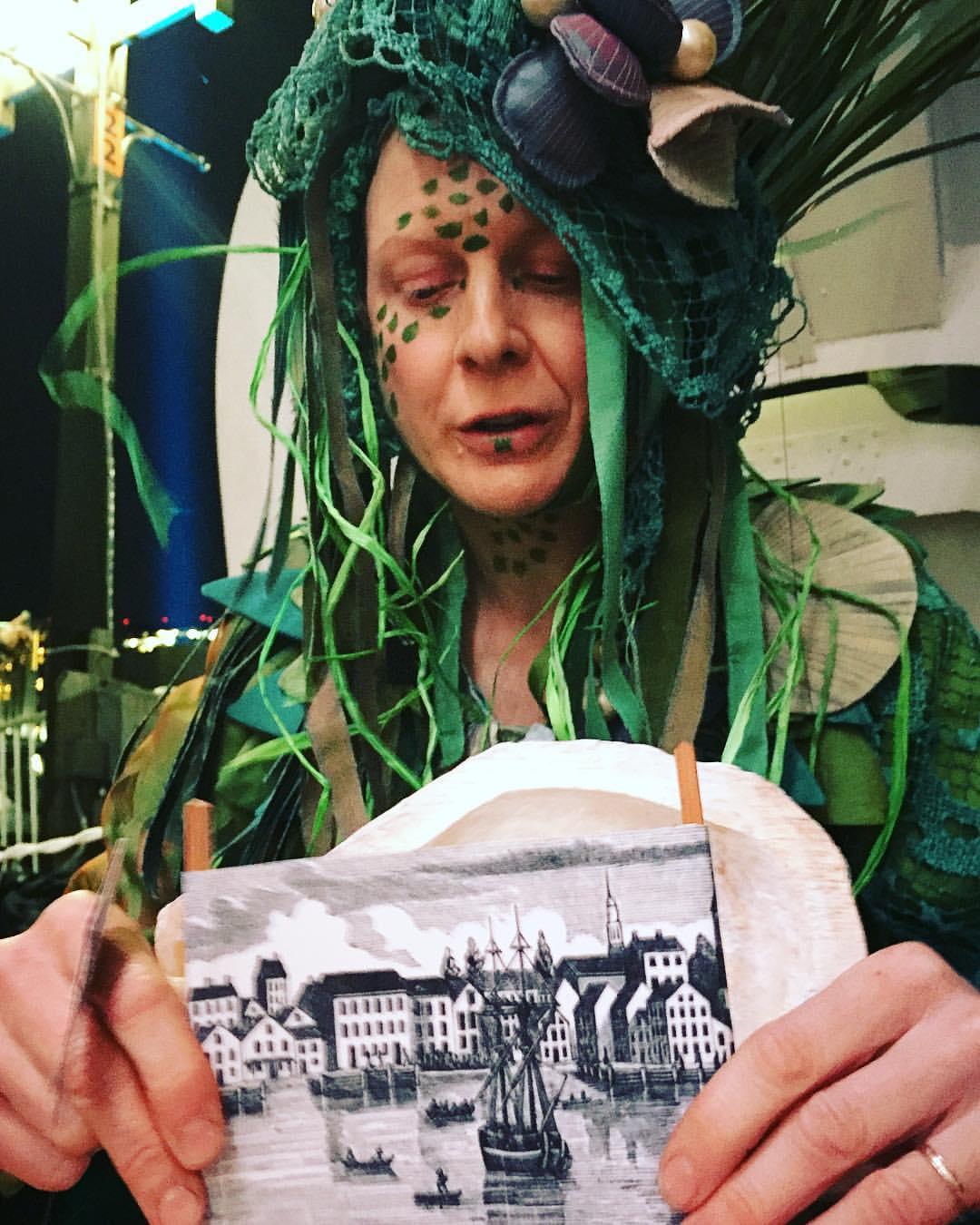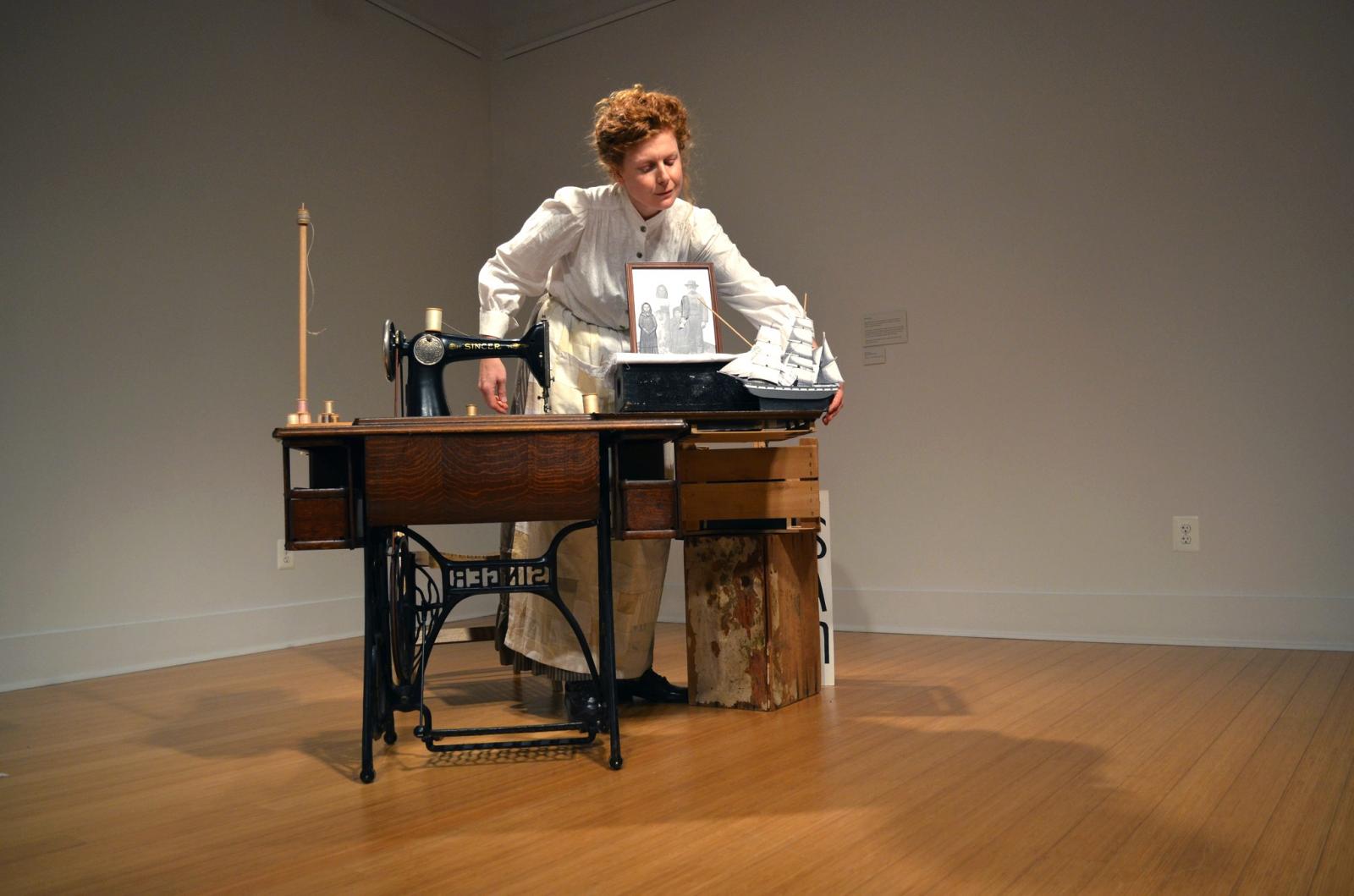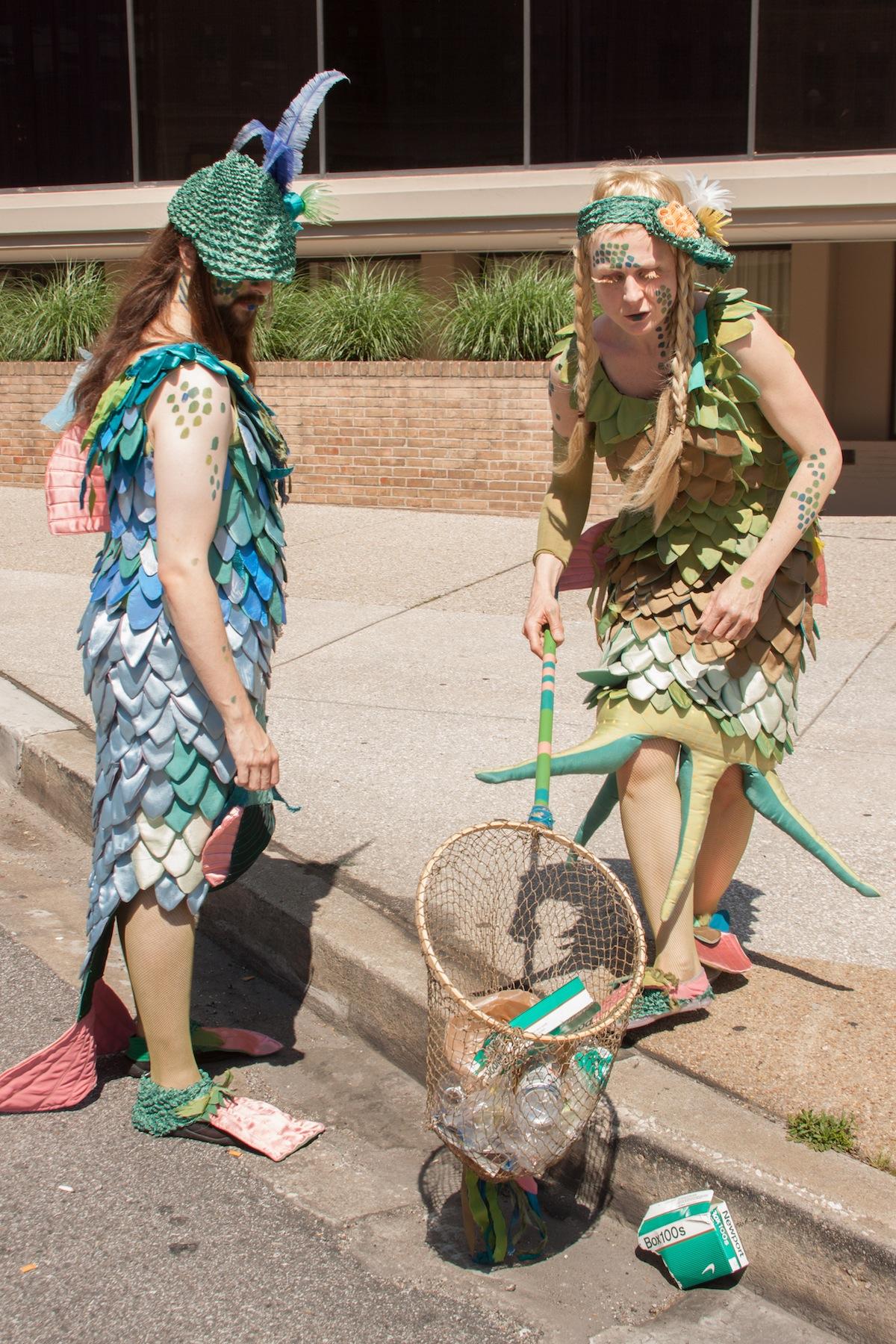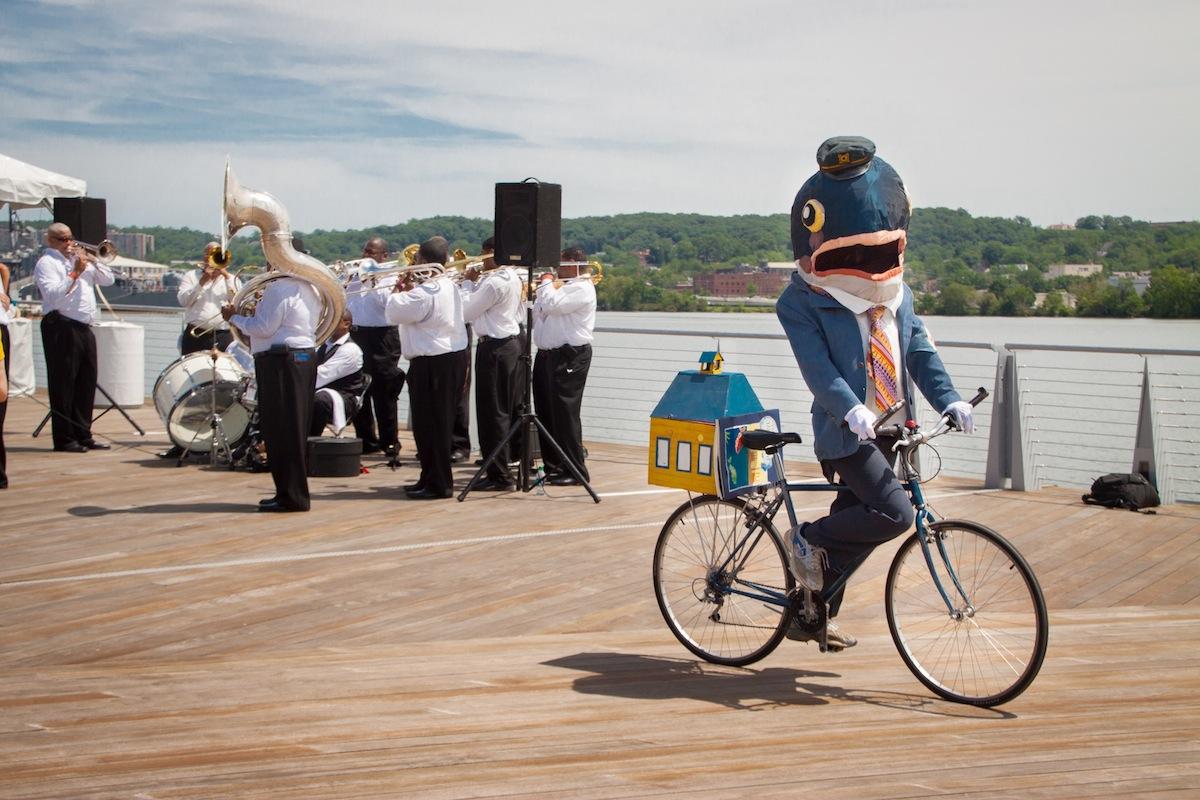About the Artist
Valeska Maria Populoh works as an educator, cultural organizer, artist and performer in Baltimore. She teaches at the Maryland Institute College of Art and is an affiliated artist with Black Cherry Puppet Theater. Valeska utilizes costume, mask and puppetry techniques to create performances and actions that respond to environmental and social concerns. An interest in acts of transformation, from materials to situations, informs her work. Valeska has performed at the International Toy Theater Festival in New York City as well as Streets Across America! organized by the Kennedy Center in 2012, Puppet Uprising in Philadelphia, the Puppeteers of America Festival and The Creative Alliance in Baltimore. She has been a curator and coordinator of the Transmodern Performance Festival and is the co-founder of the Puppet Slamwich! at Black Cherry Puppet Theater.Artist's Statement
I have been exploring the impacts of industrialization and ecological devastation on our relationships with one another, to the places we inhabit and to the natural world. Mask and costume, procession and parade, puppetry and visual storytelling, fiber and textile traditions inform my work. My relationships to local communities and environments, and the metaphoric potential of materials are important to me. My performances propose the possibility of personal and societal transformation through labor, acts of devotion and popular education. Collaborating with and learning from other artists, community organizations and performance groups is vital to my work.Featured Work
Photos






Featured Work: Photos
The Holey Land
scrolling panoramic artwork with storytelling performance
2015
“The Holey Land” is an allegory about the powerful connection between people and the place they call home. In this tale, the Peninsula People and the magic in their land are threatened when a stranger shows up with big ideas for ‘improving’ their community. As storybook images scroll by, the peninsula gets devoured by buildings and factories, and the Peninsula People are left to ponder the fate of their land. The story ends with a surprising twist, and a hopeful message about a community’s ability to determine their own future.
Told using a crankie, or wooden box that contains a long scroll of paper with illustrations. the story is inspired by the environmental history of the Fairfield Peninsula, near Curtis Bay in south Baltimore. Once fertile land that supplied produce to the booming metropolis of Baltimore, and later home to company towns and tight knit communities, the peninsula was transformed by opportunistic development, and devoured by heavy industry in the 20th century.
The 15-minute story is appropriate for all ages and is accompanied by an original score by ellen cherry.
Riparia
multi-media interactive performance
2017
Riparia is an ongoing performance project motivated by my interest in storytelling as a potent and ancient form of popular edutainment. Specifically, I am interested in how storytelling and interactive performance generate curiosity and exchange between performer and audience, and allow participants to learn more about the place they inhabit.
Riparia conducts ‘Web of Life Card Readings’ using a (still-evolving) deck of cards, emblazoned with images representing ecological and political themes. Tapping into popular interest in ‘fortune-telling’, Riparia does not claim to augur the future. Rather, the act of pulling cards effects a temporary, introspective space in which people are guided in responding to the images, reflecting on their relationship to the land, to their communities and to the forces of destruction and restoration. Riparia also utilizes a hand-sewn map of the Chesapeake Watershed and a small theater set inside an oyster shell (‘The Pearl’) to share stories about the history and ecology of this bioregion and explore people’s relationships to the Chesapeake and the bodies of water near their place of birth.
The performances are intimate events for one or two people at a time.
The Holey Land
wooden crankie with 50-foot long scroll of collaged images using hand painted tyvek
2015
“The Holey Land” is an allegory about the powerful connection between people and the place they call home. In this tale, the Peninsula People and the magic in their land are threatened when a stranger shows up with big ideas for ‘improving’ their community. As storybook images scroll by, the beautiful peninsula gets devoured by buildings and factories, and the Peninsula People are left to ponder the fate of their land. The story ends with a surprising twist, and a hopeful message about a community’s ability to determine their own future.
Told using a crankie, or wooden box that contains a long scroll of paper with illustrations. the story is inspired by the environmental history of the Fairfield Peninsula, near Curtis Bay in south Baltimore. Once fertile land that supplied produce to the booming metropolis of Baltimore, and later home to company towns and tight knit communities, the peninsula was transformed by opportunistic development, and devoured by heavy industry in the 20th century.
“The Holey Land” is an allegory about the powerful connection between people and the place they call home. In this tale, the Peninsula People and the magic in their land are threatened when a stranger shows up with big ideas for ‘improving’ their community. As storybook images scroll by, the beautiful peninsula gets devoured by buildings and factories, and the Peninsula People are left to ponder the fate of their land. The story ends with a surprising twist, and a hopeful message about a community’s ability to determine their own future.
Told using a crankie, or wooden box that contains a long scroll of paper with illustrations. the story is inspired by the environmental history of the Fairfield Peninsula, near Curtis Bay in south Baltimore. Once fertile land that supplied produce to the booming metropolis of Baltimore, and later home to company towns and tight knit communities, the peninsula was transformed by opportunistic development, and devoured by heavy industry in the 20th century.
The Garment Workers' Tale
costume made with recycled textiles, singer sewing machine, various crates and toy theater props and characters made with paper and board
2012
“The Garment Worker’s Tale” follows the journey of a young immigrant who leaves her home country to seek her fortune in America. The story is inspired by historic accounts of garment workers at the end of the 19th century in Baltimore and New York City, and by events like the Triangle Shirt Waist Factory Fire. The puppets are based on archival photos of immigrants and garment workers of the time, and the buildings and on historic street scenes of Baltimore. There is no dialogue or spoken narrative. The performance is accompanied only by a real time, electronic score created and assembled by Baltimore-based composers Jonah Beram and Patrick McMinn. There is no spoken text. Musical motifs for the characters were adapted from songs written in Baltimore by immigrant composers of the period. These fragments were developed into set pieces that play through the performance. A series of audio collages provide atmospheric backing. These are crafted by a custom software that stitches together recordings of small domestic objects in real time.
Charm City Merfolk
costumes and props made from recycled salvaged and second-hand materials and textiles, hand-sewing and embellishment
2012
A walkabout performance featuring two centuries-long residents of the Chesapeake Bay who have left their native waters in order to understand the source of its destruction. In search of answers and possible solutions, they wander the streets of Baltimore, interviewing its residents, intercepting debris before it enters the waterways and crafting merfolk charms from plastic bottles. These sea-life charms serve as a kind of exchange for donations of plastic bottles from humans and their promises to help restore the Chesapeake.
PHOTO credit: Anastasia Tantaros and www.annekaphotography.com/
Professor Bluegill and His Harbor School of Fish
Salvaged and repurposed second-hand clothing and textiles, hand-sewing and embellishment
2011
This interactive performance invites audiences into an imaginary classroom in which Professor Bluegill reads a story to his School of Fish. The story, titled The Tale of Tip and Flo, is a fable about two fish and their misadventures in a polluted Chesapeake Bay.

